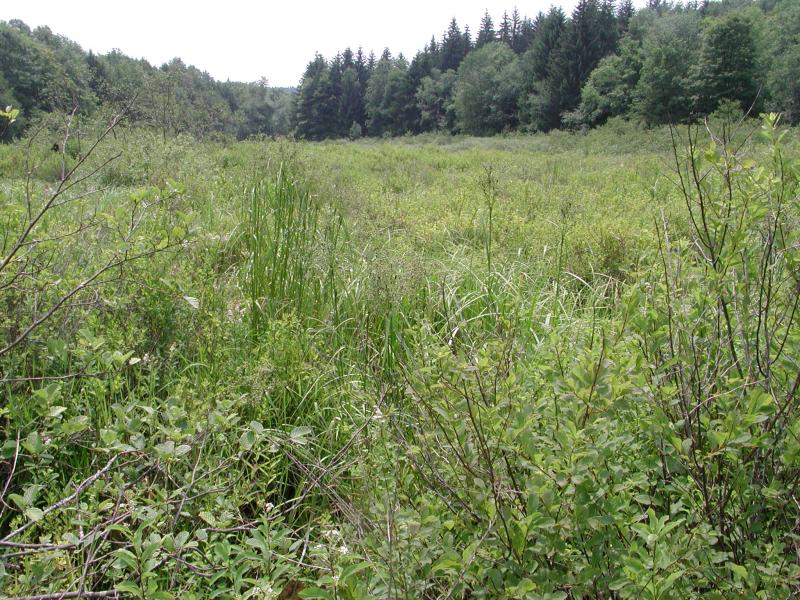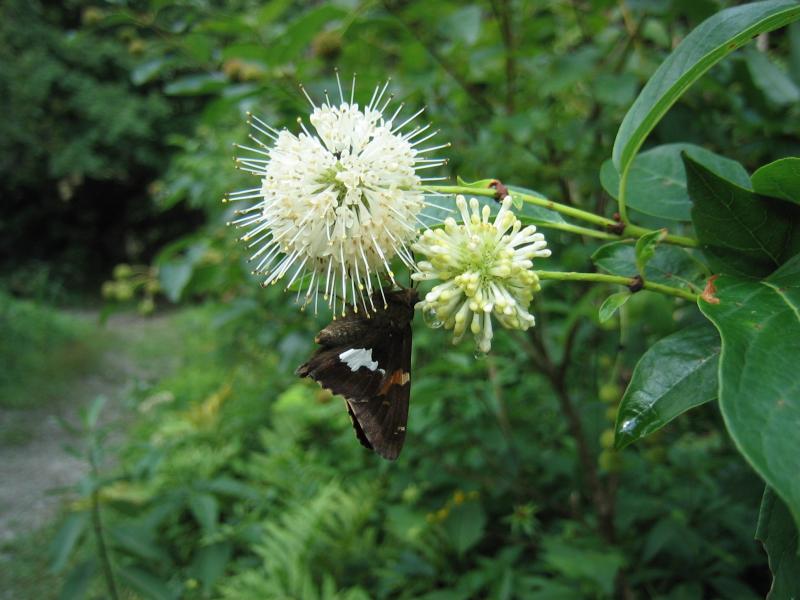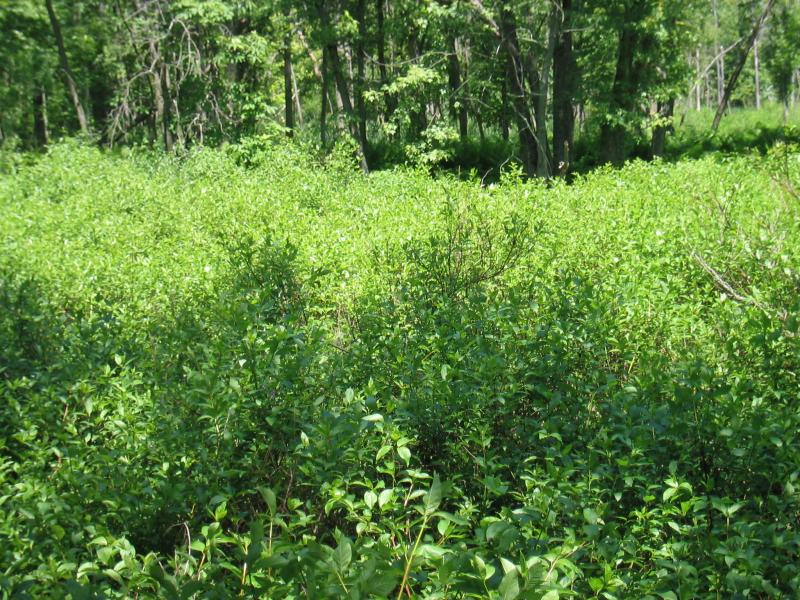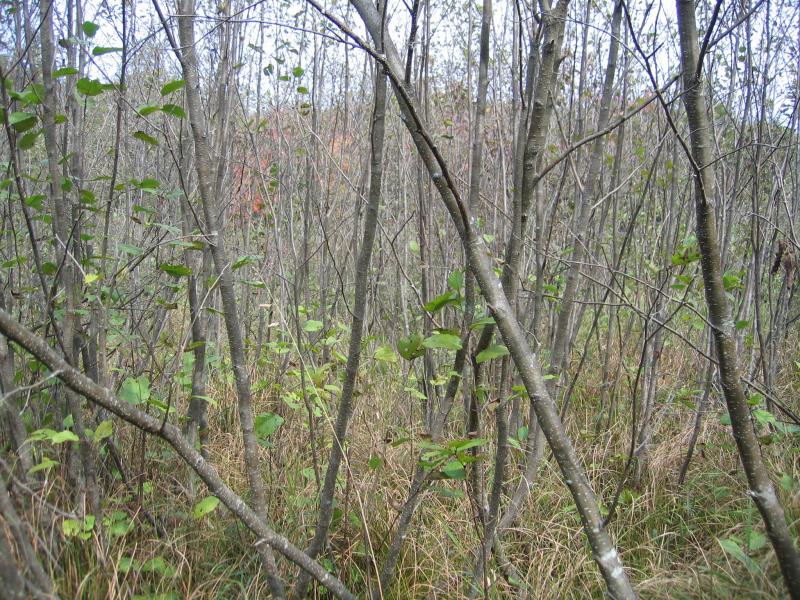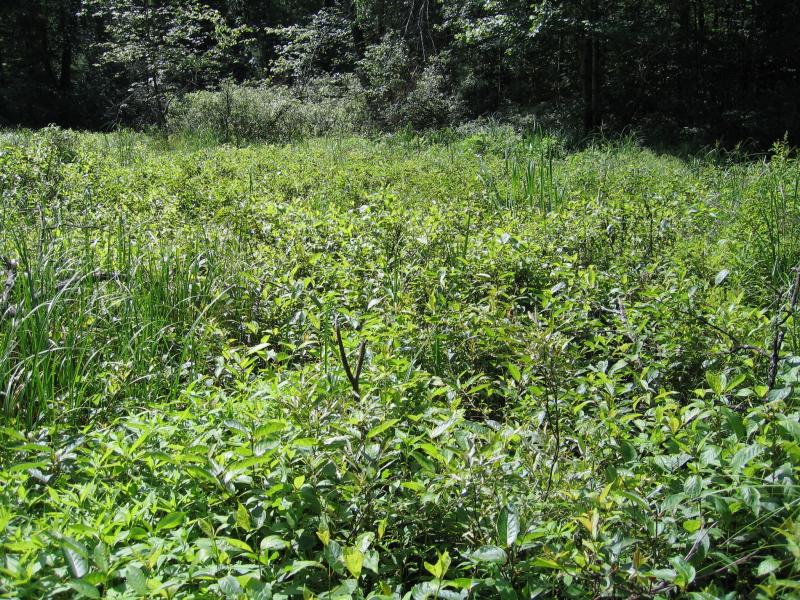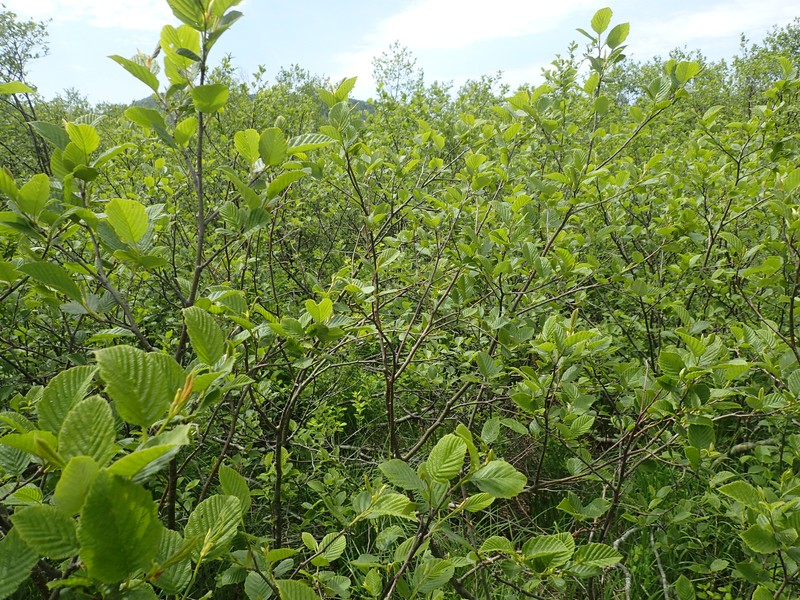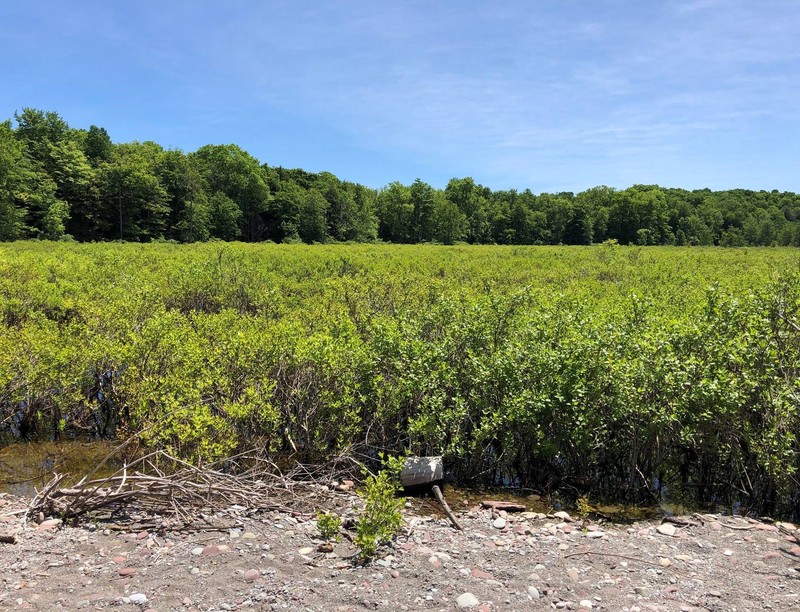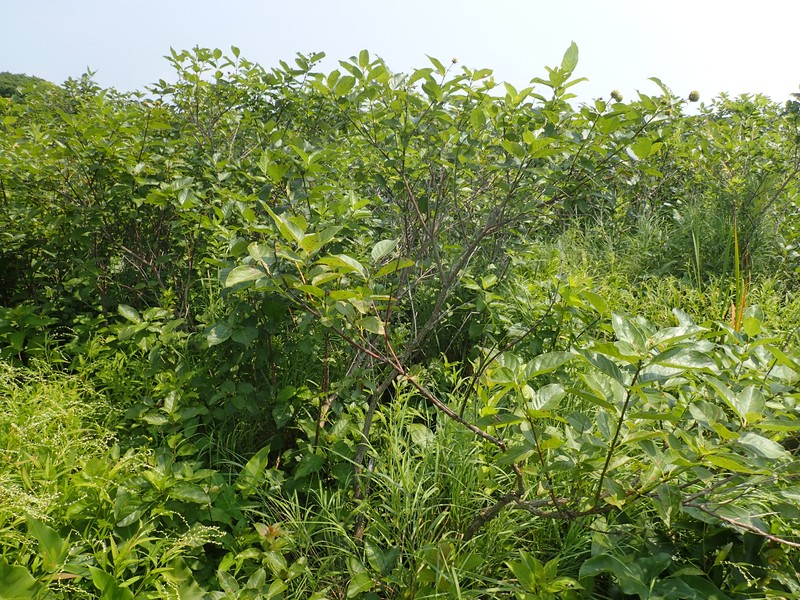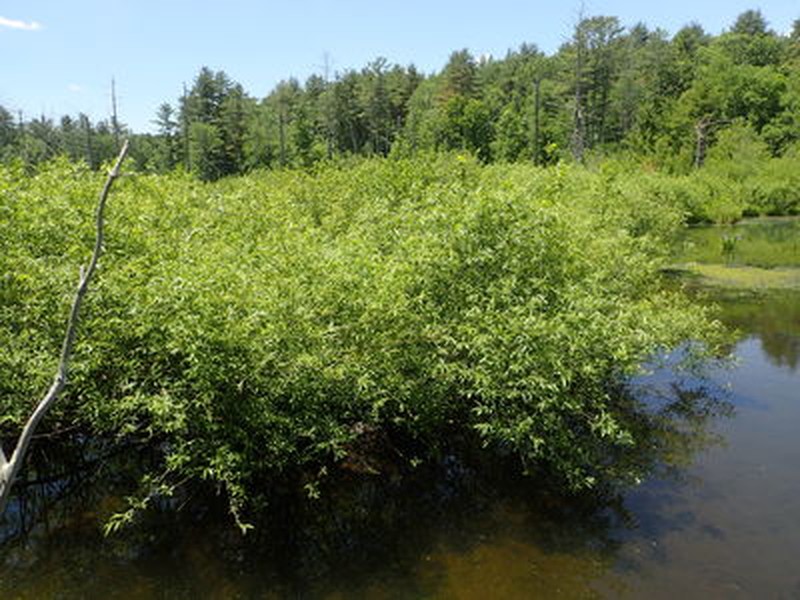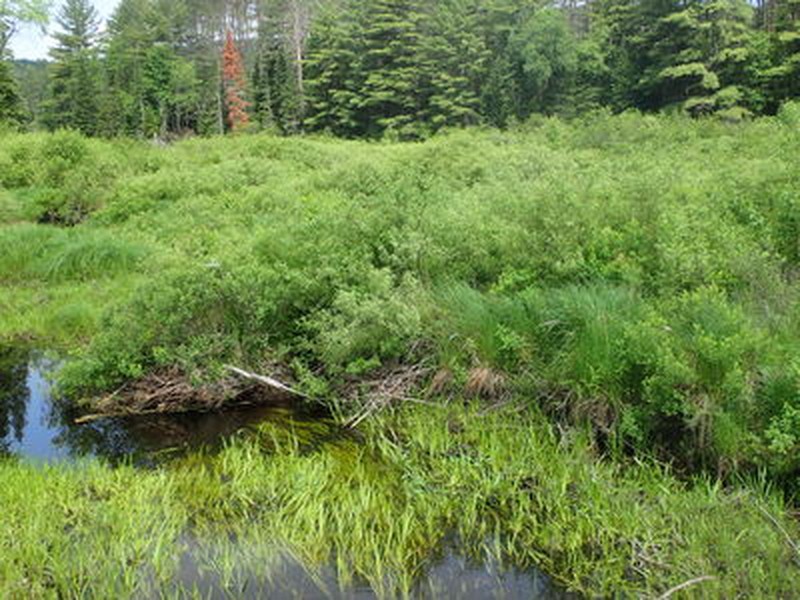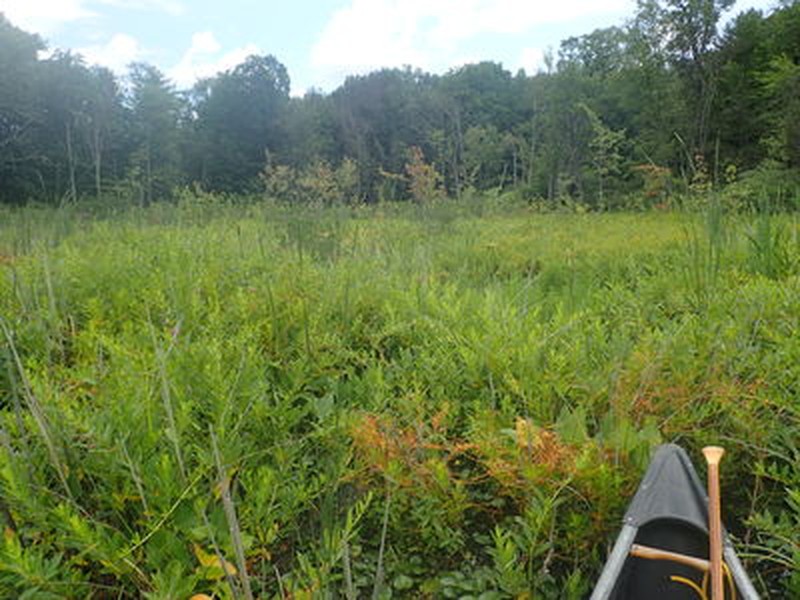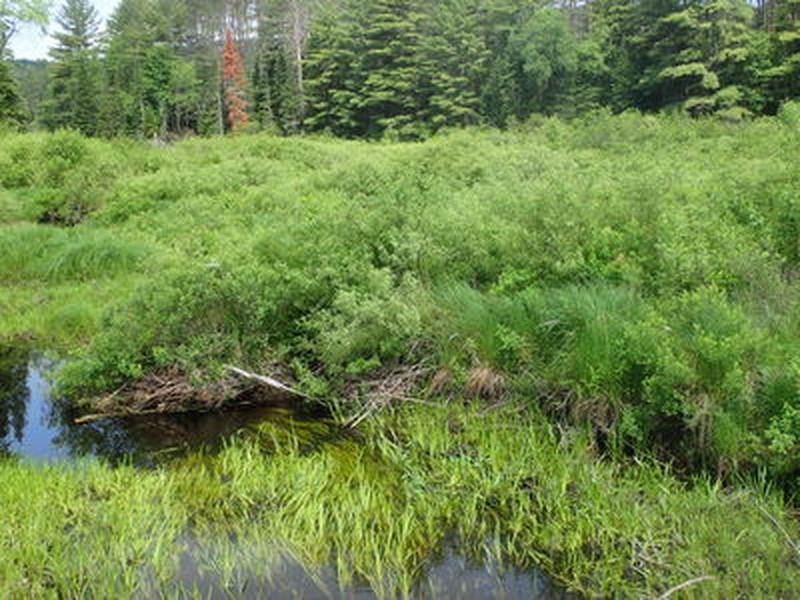Shrub Swamp
- System
- Palustrine
- Subsystem
- Open Mineral Soil Wetlands
- State Protection
- Not Listed
Not listed or protected by New York State.
- Federal Protection
- Not Listed
- State Conservation Status Rank
- S3S4
Vulnerable in New York, or Apparently Secure - Vulnerable to disappearing from New York (but not currently imperiled), with relatively few populations or locations, few individuals, and/or restricted range; or uncommon but not rare in New York; may be rare in some parts of the state; possibly some cause for long-term concern due to declines or other factors. More information is needed to assign either S3 or S4.
- Global Conservation Status Rank
- G5
Secure globally - Common in the world; widespread and abundant (but may be rare in some parts of its range).
Summary
Did you know?
Speckled alder (Alnus incana ssp. rugosa) is a nitrogen-fixing shrub that has been found to increase the concentration of inorganic nitrogen in the surface waters of the Adirondacks. Native Americans used speckled alder in combination with bloodroot, wild plum, and red osier dogwood (Cornus sericea) to make a scarlet dye for porcupine quill embroidery. Inuit people and settlers extracted a dark dye from the bark for tanning and staining hides. The bark was boiled to make medicinal teas for treating rheumatism and was also applied to wounds as a poultice to reducing bleeding and swelling.
State Ranking Justification
There are several thousand shrub swamps statewide. Some documented occurrences have good viability and many are protected on public land or private conservation land. This community has statewide distribution, and includes a few large, high quality examples. The current trend of this community is probably stable for occurrences on public land and private conservation land, or declining slightly elsewhere due to moderate threats that include alteration of the natural hydrology and invasive species.
Short-term Trends
The number and acreage of shrub swamps in New York have probably remained stable in recent decades as a result of wetland protection regulations. There may be a few cases where this community has increased as a result of abandoned agriculture land.
Long-term Trends
The number and acreage of shrub swamps in New York have substantially declined (50-75%) from historical numbers likely correlated to the alteration to the natural hydrology and to direct destruction, especially near urban areas.
Conservation and Management
Threats
Shrub swamps are threatened by development and its associated run-off (e.g., agriculture, residential, roads/bridges), habitat alteration (e.g., pollution, nutrient loading, excessive logging in adjacent uplands), and recreational overuse (e.g., trash dumping, motor boating). Alteration to the natural hydrological regime is also a threat to this community (e.g., impoundments, blocked culverts, beaver). Several shrub swamps are threatened by invasive species, such as purple loosestrife (Lythrum salicaria), reedgrass (Phragmites australis), non-native shrub honeysuckles (Lonicera spp.), European buckthorn (Rhamnus cathartica), autumn olive/Russian olive (Elaeagnus umbellata, E. angustifolia), multiflora rose (Rosa multiflora), glossy buckthorn (Frangula alnus), and frog-bit (Hydrocharis morsus-ranae).
Conservation Strategies and Management Practices
Where practical, establish and maintain a natural wetland buffer to reduce storm-water, pollution, and nutrient run-off, while simultaneously capturing sediments before they reach the wetland. Buffer width should take into account the erodibility of the surrounding soils, slope steepness, and current land use. Wetlands protected under Article 24 are known as New York State "regulated" wetlands. The regulated area includes the wetlands themselves, as well as a protective buffer or "adjacent area" extending 100 feet landward of the wetland boundary (NYS DEC 1995). If possible, minimize the number and size of impervious surfaces in the surrounding landscape. Avoid habitat alteration within the wetland and surrounding landscape. For example, roads and trails should be routed around wetlands, and ideally not pass through the buffer area. If the wetland must be crossed, then bridges and boardwalks are preferred over filling. Restore past impacts, such as removing obsolete impoundments and ditches in order to restore the natural hydrology. Prevent the spread of invasive exotic species into the wetland through appropriate direct management, and by minimizing potential dispersal corridors, such as roads.
Development and Mitigation Considerations
When considering road construction and other development activities, minimize actions that will change what water carries and how water travels to this community, both on the surface and underground. Water traveling over-the-ground as runoff usually carries an abundance of silt, clay, and other particulates during (and often after) a construction project. While still suspended in the water, these particulates make it difficult for aquatic animals to find food; after settling to the bottom of the system, they bury small plants and animals and alter the natural functions of the community in many other ways. Thus, road construction and development activities near this community type should strive to minimize particulate-laden run-off into this community. Water traveling on the ground or seeping through the ground also carries dissolved minerals and chemicals. Road salt, for example, is becoming an increasing problem both to natural communities and as a contaminant in household wells. Fertilizers, detergents, and other chemicals that increase the nutrient levels in wetlands cause algal blooms and eventually an oxygen-depleted environment in which few animals can live. Herbicides and pesticides often travel far from where they are applied and have lasting effects on the quality of the natural community. So, road construction and other development activities should strive to consider: 1. how water moves through the ground, 2. the types of dissolved substances these development activities may release, and 3. how to minimize the potential for these dissolved substances to reach this natural community.
Inventory Needs
Survey for occurrences statewide to advance documentation and classification of shrub swamps. A statewide review of shrub swamps is desirable. Continue searching for large sites in good condition (A- to AB-ranked).
Research Needs
Research composition of shrub swamps statewide in order to characterize variations. Collect sufficient plot data to support the recognition of several distinct shrub swamp types based on composition and by ecoregion (e.g., Alnus spp. dominant, Cephalanthus occidentalis dominant, Cornus spp. dominant, Salix spp. dominant, etc.).
Rare Species
- Betula pumila (Swamp Birch) (guide)
- Callophrys henrici (Henry's Elfin) (guide)
- Cardamine rotundifolia (Round-leaved Water Cress) (guide)
- Carex atherodes (Wheat Sedge) (guide)
- Carex conjuncta (Soft Fox Sedge) (guide)
- Carex cumulata (Clustered Sedge) (guide)
- Carex decomposita (Large-panicled Sedge) (guide)
- Carex lupuliformis (False Hop Sedge) (guide)
- Carex mitchelliana (Mitchell's Sedge) (guide)
- Carex straminea (Straw Sedge) (guide)
- Carex tenuiflora (Sparse-flowered Sedge) (guide)
- Circus hudsonius (Northern Harrier) (guide)
- Crotalus horridus (Timber Rattlesnake) (guide)
- Cuscuta cephalanthi (Buttonbush Dodder) (guide)
- Emydoidea blandingii (Blanding's Turtle) (guide)
- Fagitana littera (Marsh Fern Moth) (guide)
- Hottonia inflata (American Featherfoil) (guide)
- Liparis liliifolia (Lily-leaved Twayblade) (guide)
- Lithophane viridipallens (Pale Green Pinion Moth) (guide)
- Monarda clinopodia (Basilbalm) (guide)
- Neottia auriculata (Auricled Twayblade) (guide)
- Pedicularis lanceolata (Marsh Lousewort) (guide)
- Phlox maculata ssp. maculata (Wild Sweet William) (guide)
- Podilymbus podiceps (Pied-billed Grebe) (guide)
- Polemonium vanbruntiae (Jacob's Ladder) (guide)
- Rhododendron canadense (Rhodora) (guide)
- Rorippa aquatica (Lake Water Cress) (guide)
- Salix pyrifolia (Balsam Willow) (guide)
- Senecio suaveolens (Sweet-scented Indian Plantain) (guide)
- Sparganium natans (Small Bur-reed) (guide)
- Sylvilagus transitionalis (New England Cottontail) (guide)
- Vermivora chrysoptera (Golden-winged Warbler) (guide)
Range
New York State Distribution
Widespread throughout the state, including the coastal areas and represented by different regional variants. Alder-dominated swamps are widespread throughout the northern Appalachian portion of the northern third of New York and probably extend south as small patches in the lower New England and Great Lakes areas.
Global Distribution
This physiognomically broadly-defined community is likely to be widespread worldwide. Examples with the greatest biotic affinities to New York occurrences are suspected to span north to southern Canada, west to Minnesota, southwest to Indiana and Tennessee, southeast to Georgia, and northeast to Nova Scotia.
Best Places to See
- West Branch Sacandaga River (Hamilton County)
- Conewango Creek Forest
- South Branch Grass River Colton (St. Lawrence County)
- Harris Bay Marsh (Warren County)
- East Mud Lake
- Jordan River
- Cattaraugus Creek Balsam (Wyoming County)
- Shingle Shanty Brook (Hamilton County)
- West Branch Oswegatchie River Diana (Lewis County)
- Mad River Swamp (Lewis County)
- East Branch Fish Creek (Lewis County)
Identification Comments
General Description
A shrub swamp is an inland wetland dominated by tall shrubs that occurs along the shore of a lake or river; in a wet depression or valley not associated with lakes; or as a transition zone between a marsh, fen, or bog and a swamp or upland community. The substrate is usually mineral soil or muck. This is a very broadly defined type that includes several distinct communities and many intermediates. In northern New York many shrub swamps are dominated by alder (Alnus incana ssp. rugosa); these swamps are sometimes called alder thickets. A swamp dominated by red osier dogwood (Cornus sericea), silky dogwood (C. amomum), and willows (Salix spp.) may be called a shrub carr. Along the shores of some lakes and ponds there is a distinct zone dominated by waterwillows (Decodon verticillatus) and/or buttonbush (Cephalanthus occidentalis) which can sometimes fill a shallow basin. Birds that may be found in shrub swamps include both common species such as common yellowthroat (Geothlypis trichas) and swamp sparrow (Melospiza georgiana) and rare species such as the American bittern (Botaurus lentiginosus).
Characters Most Useful for Identification
Shrub swamps are very common and quite variable. They may be codominated by a mixture of species or be a near-monoculture of a single dominant shrub species. Characteristic shrubs include meadowsweet (Spiraea alba var. latifolia), steeplebush (Spiraea tomentosa), gray dogwood (Cornus racemosa), swamp azalea (Rhododendron viscosum), highbush blueberry (Vaccinium corymbosum), maleberry (Lyonia ligustrina), smooth alder (Alnus serrulata), spicebush (Lindera benzoin), willows (Salix bebbiana, S. discolor, S. lucida, S. petiolaris), wild raisin (Viburnum nudum var. cassinoides), and arrowwood (Viburnum dentatum var. lucidum).
Elevation Range
Known examples of this community have been found at elevations between 10 feet and 1,900 feet.
Best Time to See
The best time to view the diversity of plants in a shrub swamp is in the summer, from June to August. Many dogwood species (Cornus spp.) begin to bloom as early as May, but most other characteristic shrubs, including meadowsweet (Spiraea alba), buttonbush (Cephalanthus occidentalis), and sweet pepperbush (Clethra alnifolia) bloom from June or July through August.
Shrub Swamp Images
Classification
International Vegetation Classification Associations
This New York natural community encompasses all or part of the concept of the following International Vegetation Classification (IVC) natural community associations. These are often described at finer resolution than New York's natural communities. The IVC is developed and maintained by NatureServe.
- Gray Alder - Dogwood species / Devil's Darning-Needles Alluvial Shrub Swamp (CEGL006062)
- Speckled Alder - Catberry / Peatmoss species Acidic Peatland (CEGL006158)
- Common Buttonbush / Sedge species Midwest Shrub Swamp (CEGL002190)
- Common Buttonbush - Swamp-loosestrife Shrub Swamp (CEGL006069)
- Red-osier Dogwood - Willow species - (Swamp Rose) Shrub Swamp (CEGL002186)
- Swamp-loosestrife Shrub Swamp (CEGL005089)
- Sweetgale - Northern Bayberry Wet Shrubland (CEGL006339)
- American Sycamore - River Birch - (Coastal Plain Willow, Black Willow) Floodplain Forest (CEGL003896)
NatureServe Ecological Systems
This New York natural community falls into the following ecological system(s). Ecological systems are often described at a coarser resolution than New York's natural communities and tend to represent clusters of associations found in similar environments. The ecological systems project is developed and maintained by NatureServe.
- Central Appalachian River Floodplain (CES202.608)
- Central Appalachian Stream and Riparian (CES202.609)
- Eastern Boreal-Sub-boreal Bog (CES103.581)
- Laurentian-Acadian Floodplain Forest (CES201.587)
- Laurentian-Acadian Wet Meadow-Shrub Swamp (CES201.582)
- Northern Atlantic Coastal Plain Dune and Swale (CES203.264)
- Northern Atlantic Coastal Plain Pond (CES203.518)
Characteristic Species
-
Trees > 5m
- Alnus serrulata (smooth alder)
- Salix spp.
-
Shrubs 2 - 5m
- Alnus incana ssp. rugosa (speckled alder)
- Cephalanthus occidentalis (buttonbush)
- Clethra alnifolia (coastal sweet-pepperbush)
- Cornus sericea (red-osier dogwood)
- Spiraea alba var. latifolia (broad-leaved meadow-sweet)
-
Shrubs < 2m
- Alnus incana ssp. rugosa (speckled alder)
- Cephalanthus occidentalis (buttonbush)
- Ilex laevigata (smooth winterberry)
- Salix spp.
-
Vines
- Vitis aestivalis (summer grape)
-
Herbs
- Bidens cernua (nodding beggar-ticks)
- Carex torta (twisted sedge)
- Decodon verticillatus (water-willow)
- Osmundastrum cinnamomeum var. cinnamomeum (cinnamon fern)
- Persicaria amphibia ssp. laevimarginata (American water smartweed)
- Persicaria arifolia (halberd-leaved tear-thumb)
- Phalaris arundinacea (reed canary grass)
- Typha angustifolia (narrow-leaved cat-tail)
-
Nonvascular plants
- Sphagnum spp.
-
Floating-leaved aquatics
- Lemna minor (common duckweed)
Similar Ecological Communities
- Dwarf shrub bog
(guide)
Dwarf shrub bogs are underlain by a layer of peat that is typically deeper than 20 cm; shrub swamps have only shallow peat or, more commonly, mineral soils.
- Highbush blueberry bog thicket
(guide)
Highbush blueberry bog thicket are underlain by a layer of peat that is typically deeper than 20 cm; shrub swamps have only shallow peat or, more commonly, mineral soils.
- Pine barrens shrub swamp
(guide)
A pine barrens shrub swamp occurs in shallow depressions on the Coastal Plain, often as a linear transition zone between a coastal plain pondshore and an upland pitch pine-dominated community. They are embedded within fire-prone communities.
- Shallow emergent marsh
(guide)
Shallow emergent marshes are dominated by herbaceous species; shrubs are typically present at significantly less than 50% cover.
Vegetation
Percent cover
This figure helps visualize the structure and "look" or "feel" of a typical Shrub Swamp. Each bar represents the amount of "coverage" for all the species growing at that height. Because layers overlap (shrubs may grow under trees, for example), the shaded regions can add up to more than 100%.
Additional Resources
References
Bray, W.L. 1915. The development of the vegetation of New York State. New York State College of Forestry, Tech. Publ. No. 3, Syracuse, NY.
Cowardin, L.M., V. Carter, F.C. Golet, and E.T. La Roe. 1979. Classification of wetlands and deepwater habitats of the United States. U.S. Fish and Wildlife Service. Washington, D.C. 131 pp.
Edinger, G. J., D. J. Evans, S. Gebauer, T. G. Howard, D. M. Hunt, and A. M. Olivero (editors). 2014. Ecological Communities of New York State. Second Edition. A revised and expanded edition of Carol Reschke’s Ecological Communities of New York State. New York Natural Heritage Program, New York State Department of Environmental Conservation, Albany, NY. https://www.nynhp.org/ecological-communities/
Edinger, Gregory J., D.J. Evans, Shane Gebauer, Timothy G. Howard, David M. Hunt, and Adele M. Olivero (editors). 2002. Ecological Communities of New York State. Second Edition. A revised and expanded edition of Carol Reschke's Ecological Communities of New York State. (Draft for review). New York Natural Heritage Program, New York State Department of Environmental Conservation. Albany, NY. 136 pp.
Levine, E. 1998. Bull's birds of New York State. Comstock Publishing Associates, Ithaca, NY.
McVaugh, R. 1958. Flora of the Columbia County area, New York. Bull. 360. New York State Museum and Science Service. University of the State of New York. Albany, NY. 400 pp.
Metzler, K.J. and R.W. Tiner. 1992. Wetlands of Connecticut. Connecticut Geological and Natural History Survey, Report of Investigations No. 13. Department of Environmental Protection, Hartford, CT.
New York Natural Heritage Program. 2024. New York Natural Heritage Program Databases. Albany, NY.
New York State Department of Environmental Conservation. 1995. Freshwater Wetlands: Delineation Manual. July 1995. New York State Department of Environmental Conservation. Division of Fish, Wildlife, and Marine Resources. Bureau of Habitat. Albany, NY.
Reschke, Carol. 1990. Ecological communities of New York State. New York Natural Heritage Program, New York State Department of Environmental Conservation. Latham, NY. 96 pp. plus xi.
Shanks, R.E. 1966. An ecological survey of the vegetation of Monroe County, New York. Proc. Rochester Academy Sci. 11:108-252.
Tiner, Ralph W., Jr. 1985. Wetlands of New Jersey. In: National wetlands inventory. U.S. Department of the Interior, Fish and Wildlife Service, Newton Corner, MA:
Links
About This Guide
This guide was authored by: Gregory J. Edinger
Information for this guide was last updated on: November 15, 2023
Please cite this page as:
New York Natural Heritage Program. 2024.
Online Conservation Guide for
Shrub swamp.
Available from: https://guides.nynhp.org/shrub-swamp/.
Accessed July 27, 2024.
